We stopped off at the Visitors Center and talked to the very nice hosts there who had just started working the day before. Then we watched the nice movie about the refuge before heading out to see what we could see. We stopped first at the alligator pond but there weren’t any alligators in the water or out basking in the sun.
We drove on to the Heron Flats stop and went out to the viewing platform for a look-see. Often times, people see Whooping Cranes from this platform but there were none to be found on Monday.
We could see lots of sandhill cranes off to the north and there was a large flock of snow geese out along the shoreline.
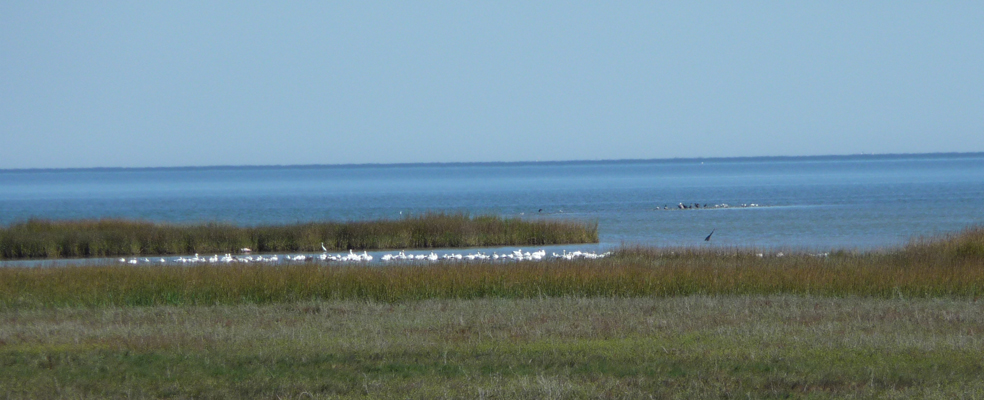
We took the Heron Flats trail out through the grasslands. There were Stiff Greenthread (Thelesperma filifolium) in bloom here and there.
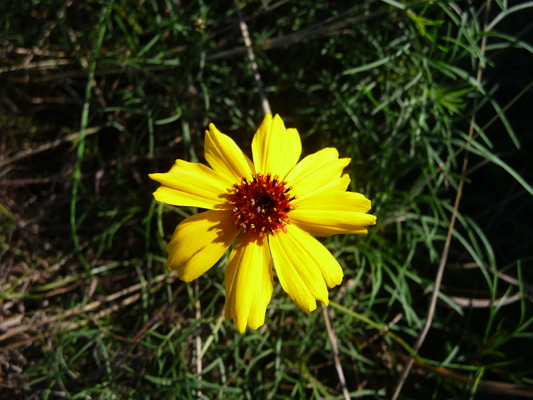
And a few of these really fun Upright Prairie Coneflowers (Ratibida coumnifera).
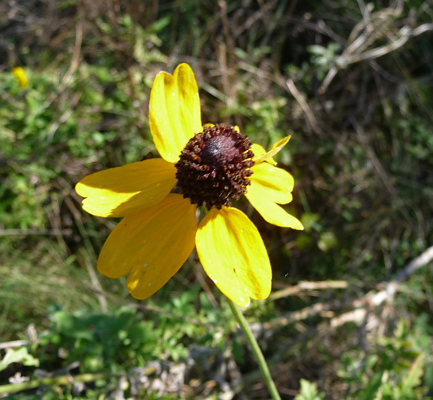
Once upon a time this had been one of those numbered nature trails with posts here and at about post # 7 there was a pond where I spied an alligator sunning on the bank.
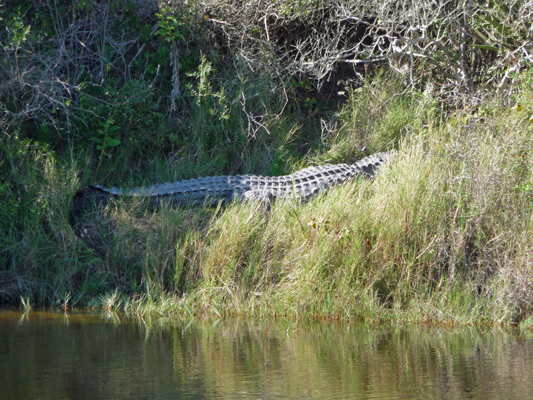
Here and there we saw small clusters of Blue Mistflower (Conoclinium coelestinum). They look like they are relatives of garden variety ageratum to me—but way taller.

We kept seeing sandhill cranes and I kept taking pictures of them, until I finally got a close enough shot that was good enough to share.
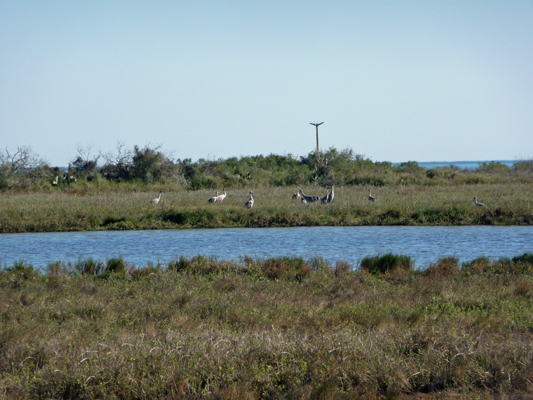
We saw one patch of Indian Blanket (Gaillardia pulchella) too.
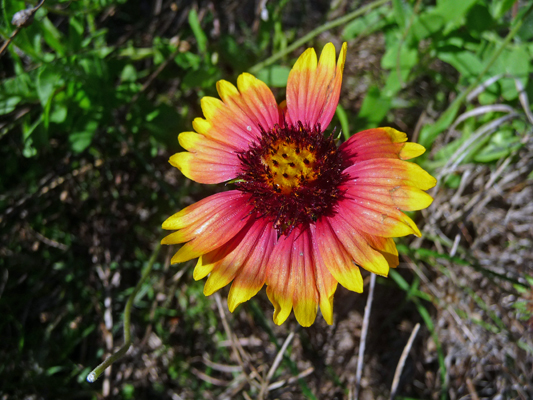
Here and there along the trail there were Spanish Daggers (Yucca treculeana). This one was taller than Walter—and yes the tips of the blades are really sharp.

We made our way out to the viewing platform at the end of the trail and had a look out across the area. The trees have grown up here so the view is a bit obscured but we enjoyed our walk anyway. This used to be a loop trail and they are currently working on fixing a bridge at the end of the loop and then will clear the brush to once again complete the loop. For now though, it’s an out and back.
On the way back, I heard some munching noises next to the trail and when I looked down there was an armadillo making its way into the grasses. Cute little guy, he sure looked a lot like Piglet from the original Winnie The Pooh books. I guess it’s the ears and the pointy nose.
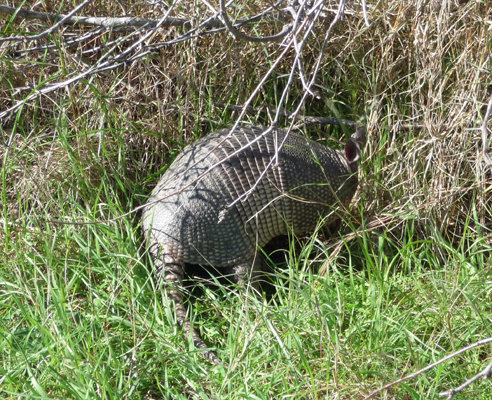
Just before we made it back to the truck, I saw this interesting plant. It’s a Green lily (Schoenocaulon drummondii) which turns out to be relatively uncommon at Aransas.
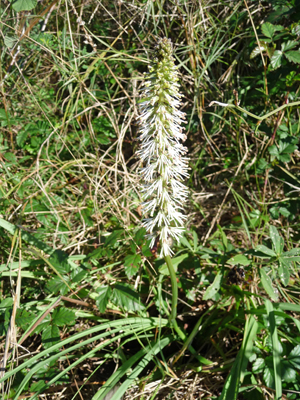
By this point it was lunch time so we stopped at the Fishing Pier picnic area and found a table with a nice view.
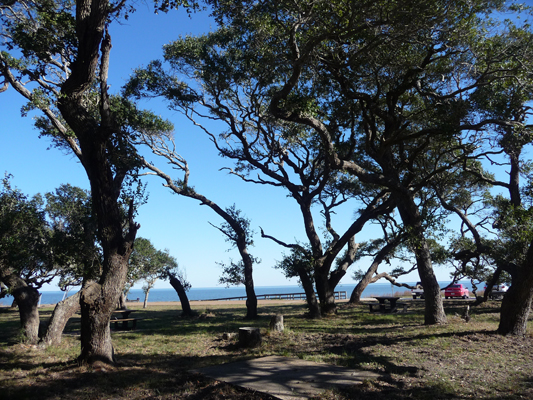
After lunch we headed to Jones Lake where I’d hoped to see purple gallinules (fancy moorhens). But instead, we saw three more alligators. The only reason we saw the first one was that the sun was reflecting of its tail.
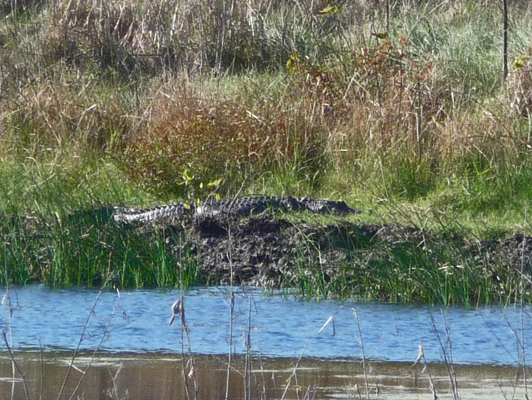
Another one was right near the water and looked at first glance like an abandoned tire or boat—but this is a wildlife refuge so that’s not a possibility. Sure enough, on closer inspection: alligator.
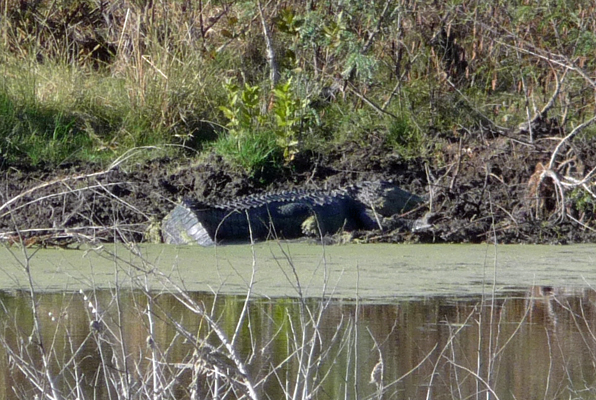
The last one was hiding in among the grasses but sure enough, it was another alligator.
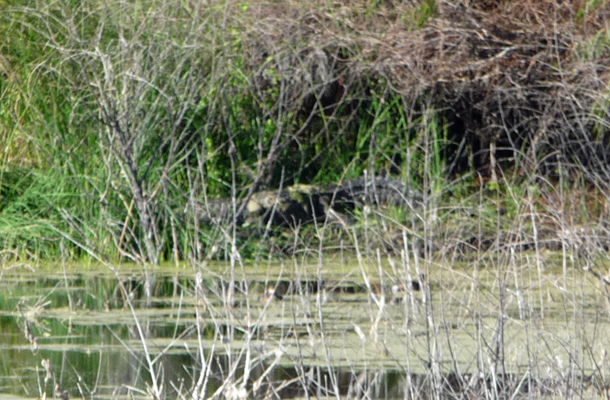
Just before we left, a nice white-tail buck came out of the brush—clearly big enough not to worry about the gators.
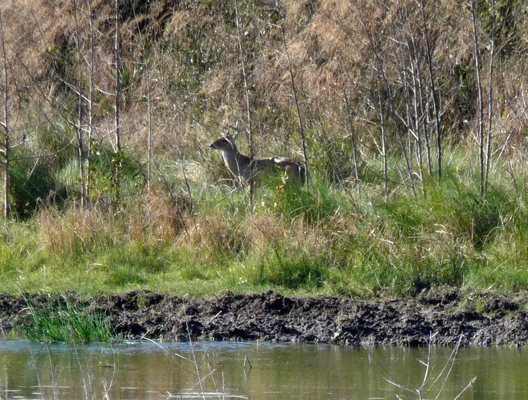
We drove on to the big observation tower at the end of the main road. There are two towers here, a lower one that looks out into the bay and a 40 foot tall one that gets you to the tree-tops. We opted to go up the higher tower and as we were climbing up the ramps a pair of black vultures circled around us and landed on the railing in front of us.
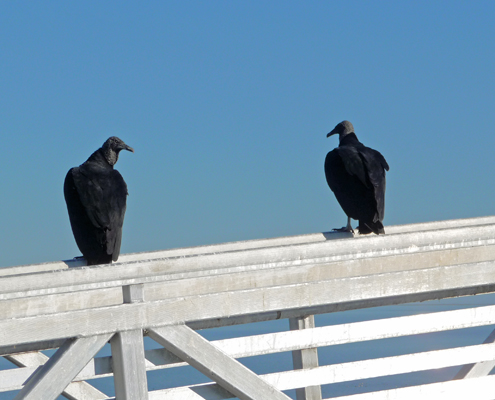
They are really used to people. This guy let me get within 3 feet of him before he took off. I’m sorry but they remind me of really evil undertakers!
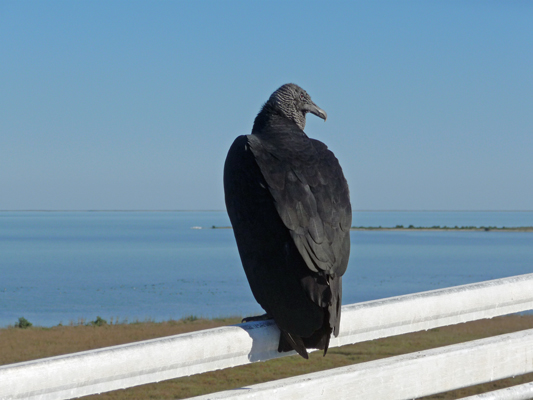
The view across the bay was lovely.
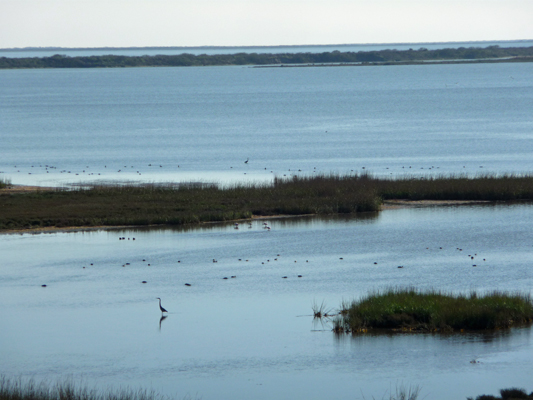
Besides that Great Blue Heron you can see in the middle there were 4 roseate spoonbills near the far shore.
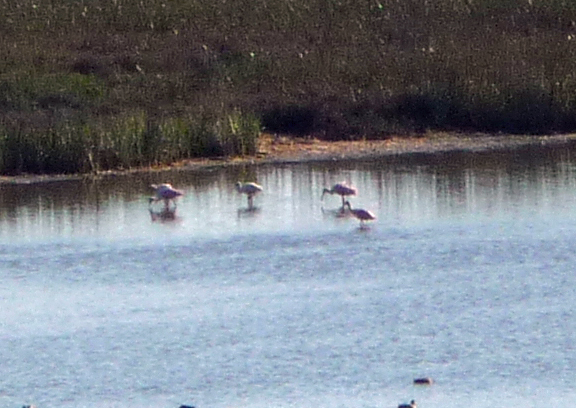
As we were standing appreciating the view I saw movement out on the near shore. A large black animal was coming out of the water. My first spontaneous thought was Hippo! And of course it wasn’t. It was a wild pig.
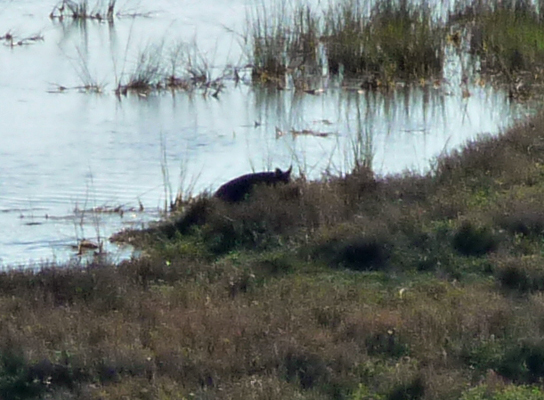
The wild pigs are not native and cause problems in the refuge because they dig up everything. They actually have a pig hunt every year to try to reduce the population some.
We had a great time up on the tower and highly recommend adding it to any visit to the Aransas National Wildlife Refuge. From here we drove the auto tour road. There were quite a few birds out in an area where they had done a controlled burn this winter but it was late afternoon and we were facing directly into the sun so we didn’t spent much time there since we couldn’t see real well. At one turn in the road we spied a doe and two yearlings in the bush though.
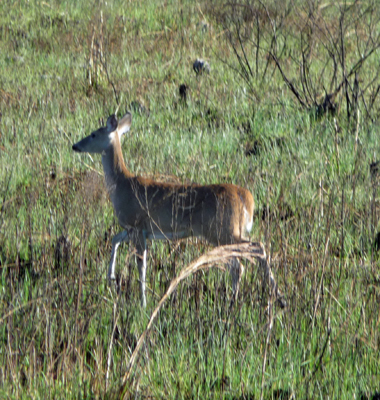
The yearlings kept moving up the road trying to get away from us. Finally they figured it out and crossed the road and bounced off into the grasses.
There are lots of vultures both in and out of the wildlife refuge—in fact I’ve never seen so many anywhere else. I guess there is lots of good carrion hereabouts (seafood in addition to land food)— because there’s quite the cleanup crew. In any case, they come home to roost in the evening in the trees near the visitors center.
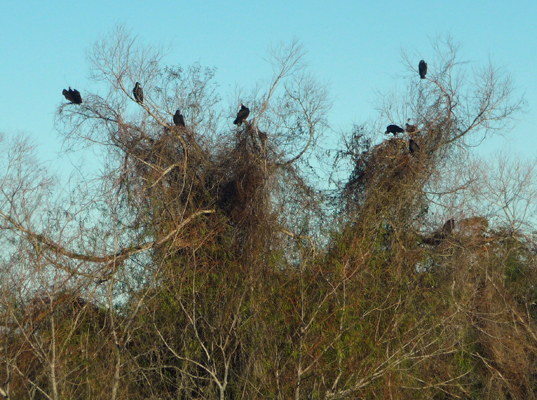
Some had their wings spread in the late afternoon sun.
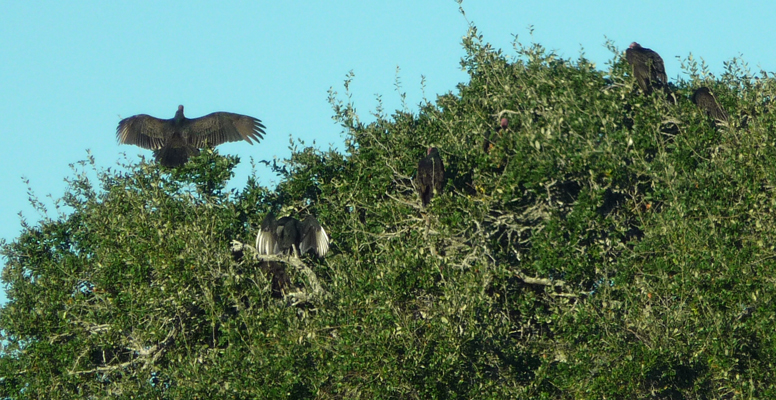
There were both black vultures like those we’d seen at the observation tower and turkey vultures (with red heads).
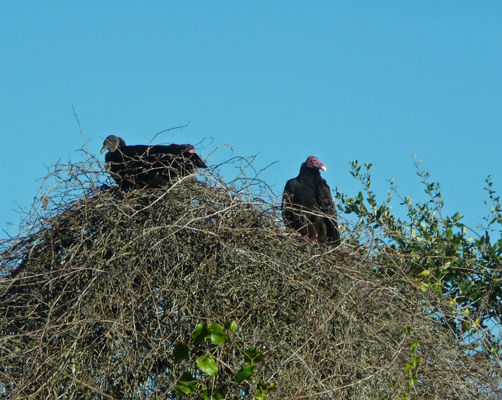
All in all it was a great day. We got an interesting drive through farmland and then along the coast; we got birds and alligators; a nice walk and a great place for lunch all on a nice sunny day with temps in the high 50’s.
The next morning we packed up and headed north along Hwy 35 (and then south a bit) to Matagorda Bay Nature Center at the mouth of the Colorado River (Texas has it’s own Colorado not to be confused with the mighty Colorado that flows from Colorado through Arizona to form the Grand Canyon and then on down to the Gulf of California).
This is a park run by the Lower Colorado River Authority (the local water and power authority). They have a nice visitors/education center and provide fishing piers along the river and a very nice RV Park with water views. We got a medium grade spot with a water view--since the park was pretty empty--all for $34 a night ($30 for the spot and $2 per person daily entry fee). Here’s our view. Only one rig moved in while we were here and they didn’t disturb the view much.
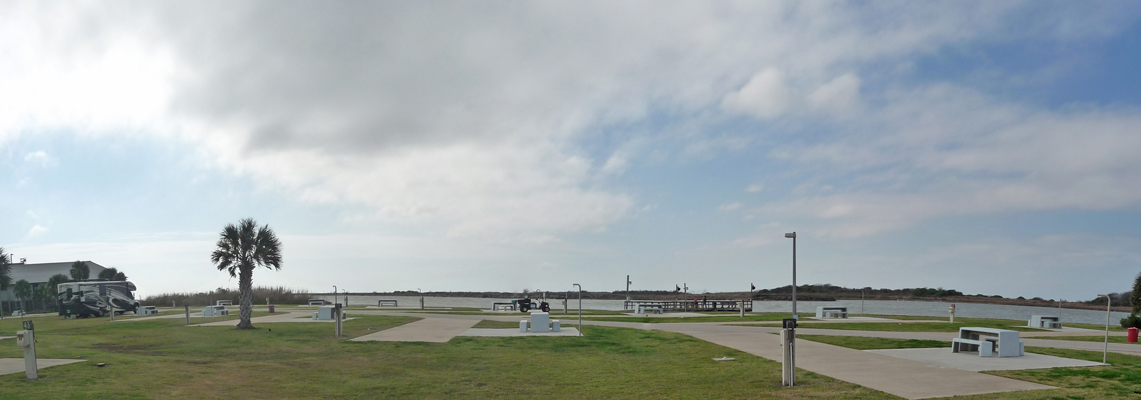
After lunch we hiked over to the visitors center and had a look at their displays—fine for kids but no big deal really. The sun was playing peek-a-boo with the clouds and I got a shot of the view from the deck overlooking the river.
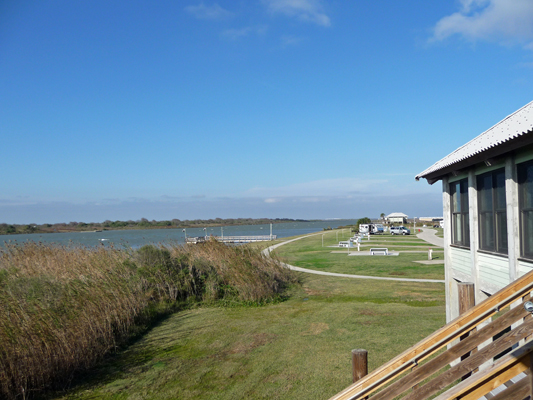
Here’s a close up of the nifty bridge that takes you over the river to reach this little peninsula.
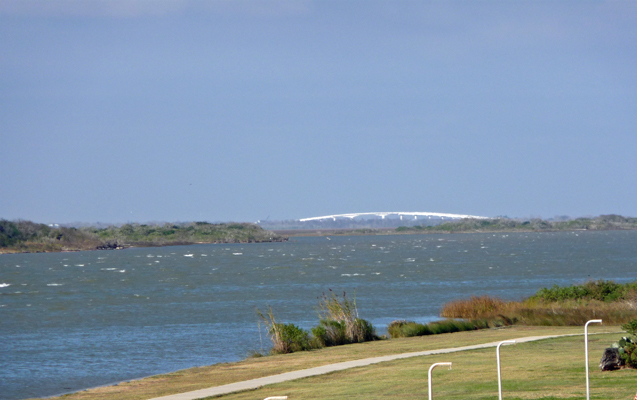
It was windy (you can see the white caps in the river) but we decided to walk along the riverside path for a ways. We stopped at one of the fishing piers and I got this shot of a snowy egret with his feathers ruffling in the wind.
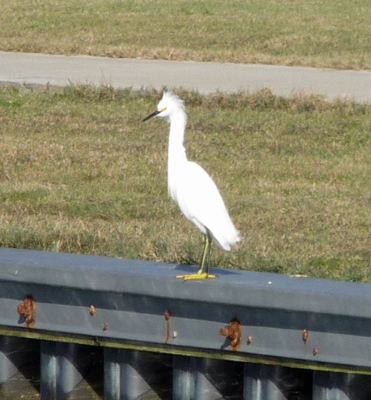
The wind continued to blow the clouds in all afternoon. Just before sunset the sun broke through to give us a bit of a show.
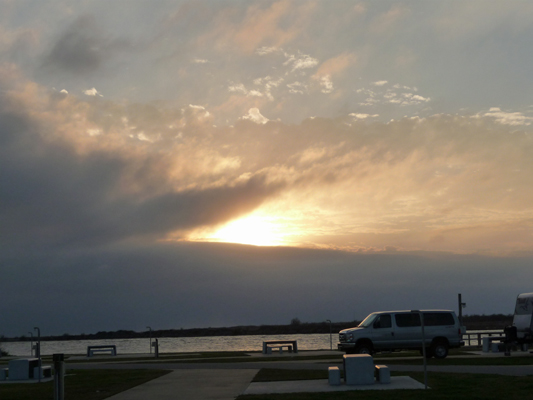
It rained in the night and we had puddles in the morning with sun breaks off and on all day. We took a drive (initially to figure out where the trash was in the RV park—at the entrance of course) and visited the Day Use Area and then the small housing development that faces out onto the dunes and the gulf. Clearly there are flood issues here—between the river and tropical storms and hurricanes--because most of the houses are up on stilts. They often have a garage on the ground floor and maybe a screened room but the living quarters are upstairs.
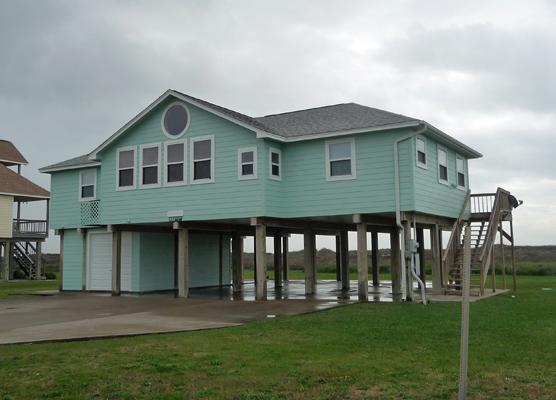
There were very few older homes here and there were several empty lots so our guess is that a lot of these houses were wiped out by one hurricane or another not that long ago.
The road didn’t go through to anywhere so we turned around and went on down the main road a ways. There were Great Egrets out in the wetlands near one of the fishing piers.
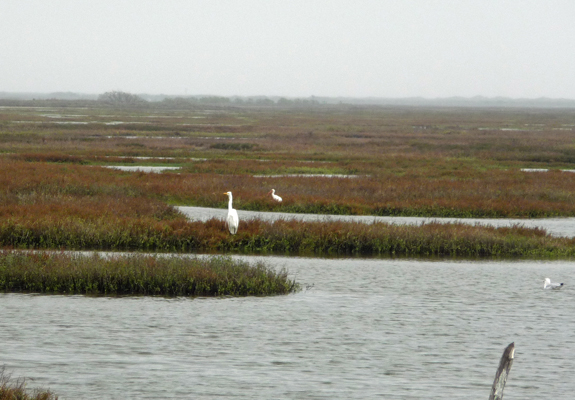
They are considerably larger than the snowy egrets and look pretty majestic when they pose.
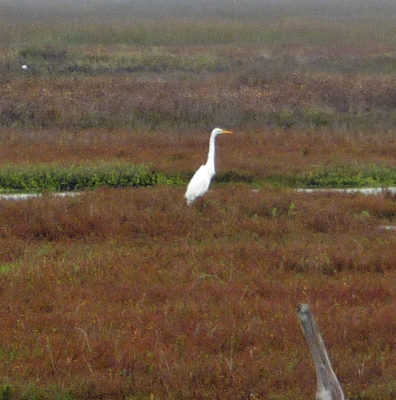
There was also a Small Blue Heron strutting his stuff out here. He wasn’t very big but he was pretty.
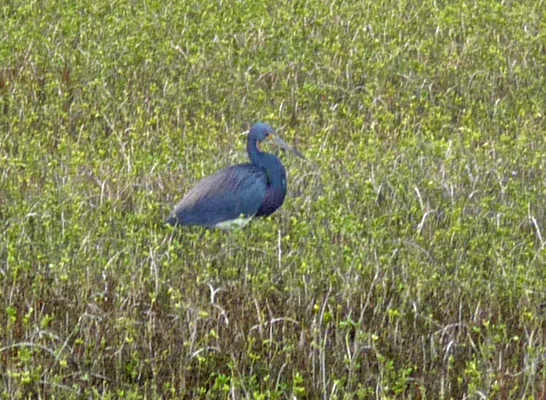
From here we drove out the beach road (the only one in the area) which runs out past another housing development and out to another beach that you can drive on—it’s 23 miles before you hit the next beach access though. This one you need a county permit for (with no info on how to get it) so people park at the edge of the pavement and walk on the beach instead.

It was blowing pretty hard and the surf was up too.
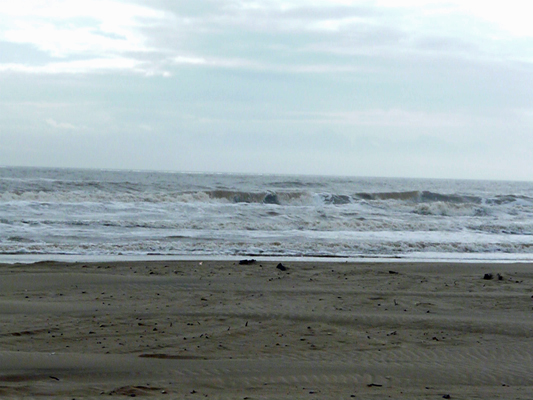
The sun peeked out and changed the way the waves looked.
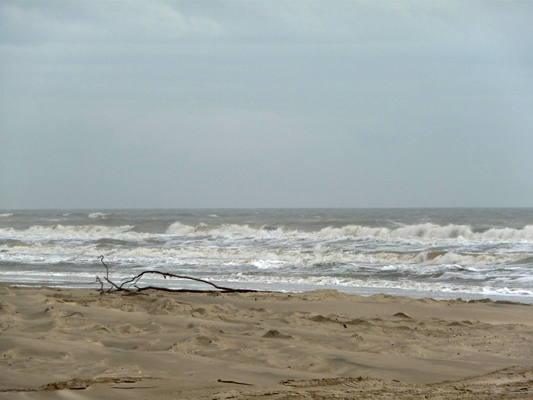
On the way back, we checked out the other housing development and I spied a Willet in his winter plumage.
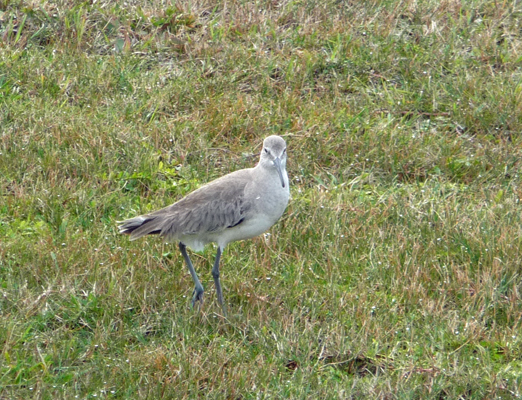
Most of the development was all the same style of duplexes up on stilts with the garages in the ground level. Up close and personal it looked a little beyond weathered and we saw lots of ‘For Rent’ signs. But there was some new construction going on too. Definitely not a great housing style to ‘age in place’ in with all those stairs.
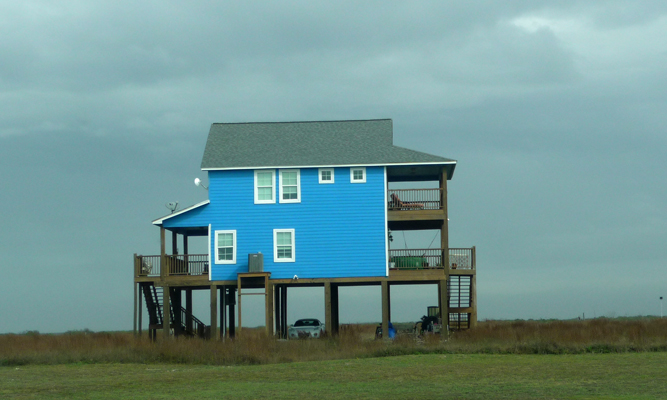
We drove on up the main road to the ‘town’ of Matagorda Bay (lots of houses along the river front and a bar/café and one restaurant). Along the way we saw a large flock of Great Egrets in the marsh. Of course they took off and landed further away as soon as we drove up—note the Great Blue Heron at the end of the row.
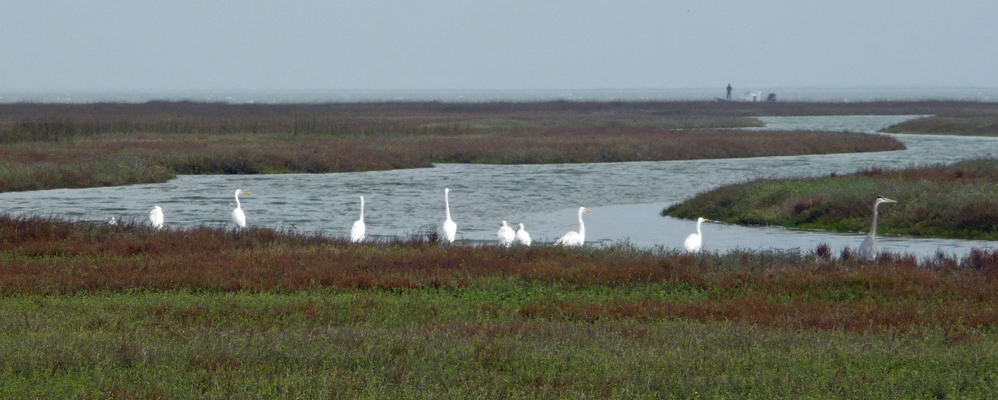
But a couple of them stayed close by.
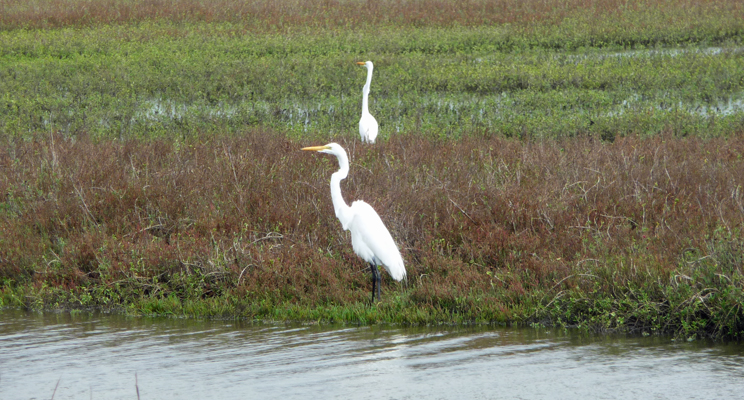
One of the things I enjoy about this area is the pastel colors of the houses. You’d never see houses this color in Washington state—the neighbors would have a fit.
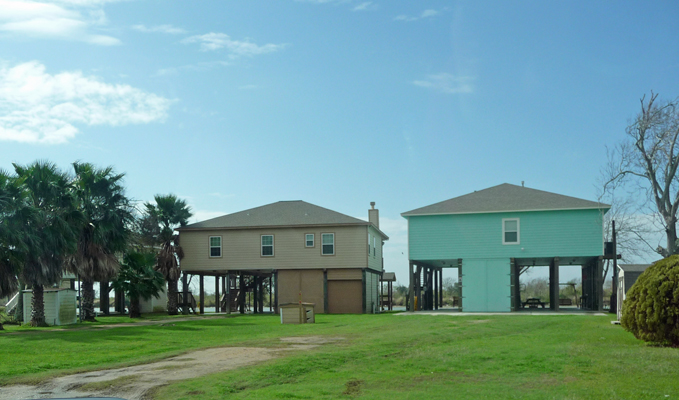
These folks all had docks on the river and they had slings for their boats so they could winch them up and have them out of the river. So as you drove along there were all these boats hanging in the air.
There is a small commercial fishery here too. There were 4 boats like this moored along the river.
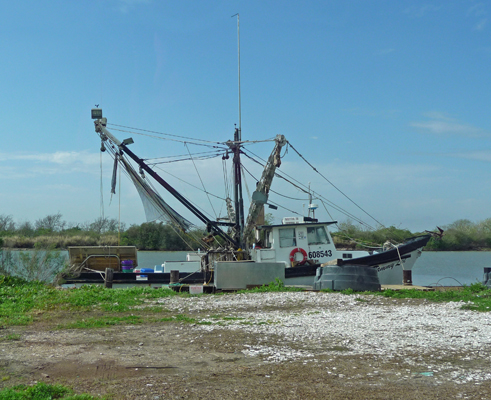
Since they all had piles of oyster shells nearby (some quite good sized) we figure that’s their main catch but they may do shrimp too.
We hung out for the afternoon watching the sun come and go and the wind blow. Late in the afternoon the sun broke through the clouds one more time (no sunset again) and put on one of those miracle shows. I think there should have been celestial music playing with this one.
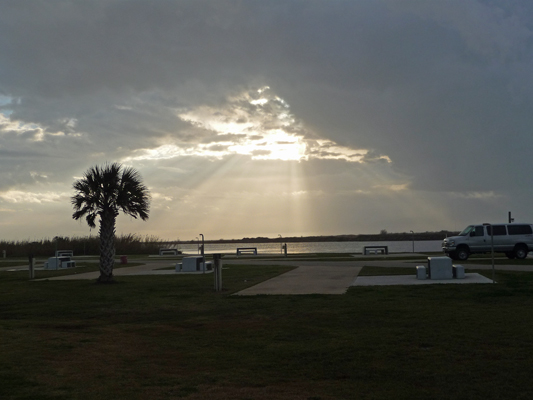
The river lit up a little later but that was too bright for the camera. And then the hole closed up and the sun was gone for the day. We had thunder showers all evening with lots of bright flashes and big thunder boomers. The campground was close enough to the ocean for us to hear the surf crashing all night too.
On Thursday January 7th, we headed northward past the Chocolate Bayou and the Brazos River and out to Follet Island and then up the island (and across the toll bridge with the narrowest toll booth entrance we’ve ever gone through) and up Galveston Island to Galveston Island State Park. Down on Follet Island there were houses but nothing too lavish. As you drive north on Galveston Island the houses get denser and bigger (some in the mansion classification as far as I’m concerned)—and they are all up on stilts. This is another barrier island so there’s nothing to protect these houses from the force of a hurricane or tropical storm. But they’re right there on the beach and no doubt have lovely breezes in the summer time.
We’d hoped to stay here for the weekend but they were full up with reservations starting on Friday so we could only stay one night—the price we pay for flexibility. There were openings on the Gulf coast side (they have a campground on the Galveston Bay side too) so we splurged and paid $25 (the bay side spots are $20) for a Gulf Coast spot near the water.
When we went to get back in the truck after registering I spied a Great Egret stalking something in the grass right in front of us.
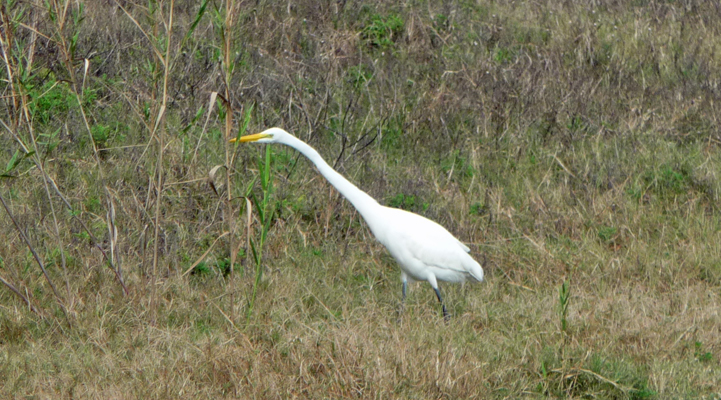
The dunes here aren’t very high but there are enough of them to keep these spots from having a water view (unless of course you had a very tall rig).
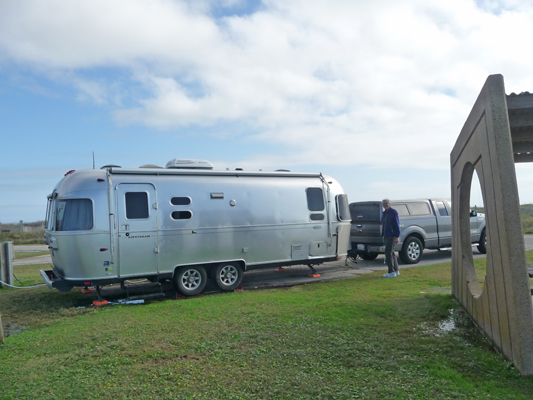
Each spot comes with one of these strange picnic shelters (we’ve seen a lot of them up and down the coast). They had them at the Day Use Area at Matagorda and they looked very eerie squatting along the horizon.
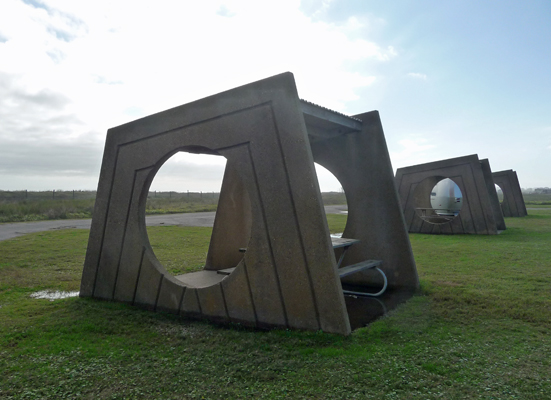
After lunch we went for a nice long walk on the beach—well actually on the trail in the dunes since the surf was so high there was very little beach. The storm the night before had clearly stirred up the surf and had left big piles of foam all along the shoreline. I did a little research and there was no information about this foam being unusual. Mostly foam (spume) is caused by organic material in the water—like dead algae after a bloom.
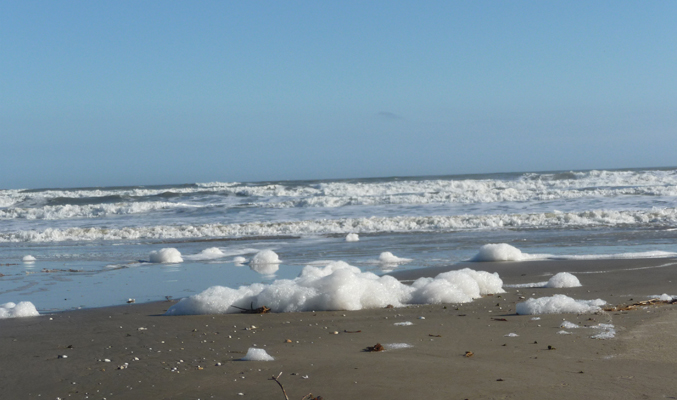
The waves left some of it high and dry up on the little bit of sand that was visible and then the wind would pick it up and flop it over and over again across the sand—pretty funny to watch. There wasn’t much wind at all (a first for us on the gulf coast) and it was in the high 60’s so it was just lovely. Fresh foam would come in with every wave moving the stuff on the beach around.
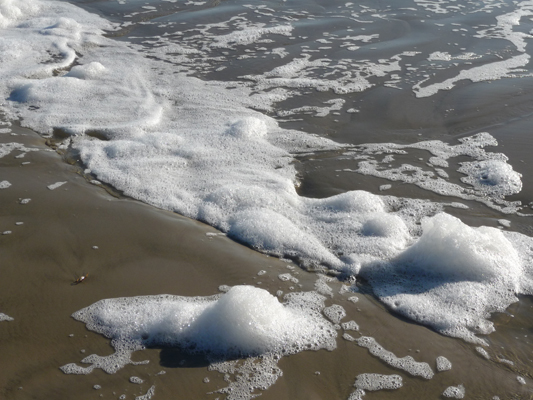
There were willets running in the waves.
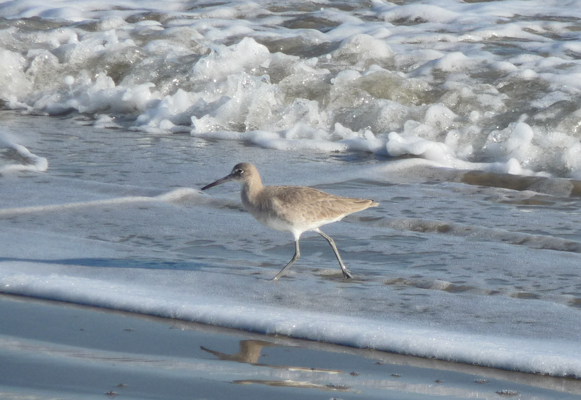
And yellow flowers with prickly leaves growing in the low sand dunes. I looked through my Texas flower book and on line and could not figure out what they were. But I suspect they are a non-native ‘weed’ since we saw them growing along the road too.

There were a pair of killdeer playing in the waves. They’re supposed to prefer the bay side but I couldn’t figure out what they could be if they weren’t killdeer.
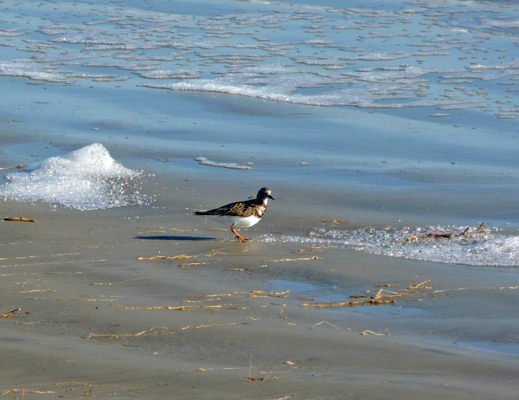
There were a number of these sweet little birds along the way. Eventually, I decided this one was a Sanderling—something I’d not seen before.
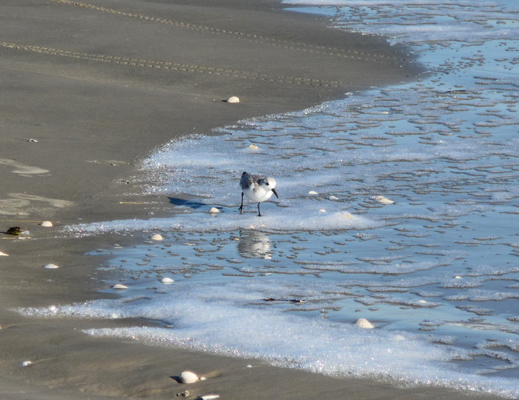
There were shells on the beach—mostly clam shells but bits and pieces of other things too. The shells, bits of driftwood and sea grass mixed with the foam made the beach pretty interesting.
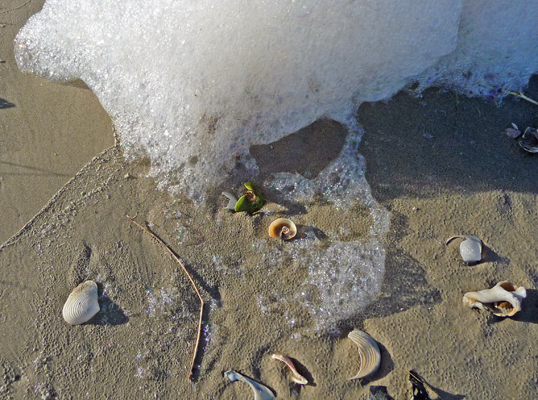
When I found a shell filled with foam, I had to make a picture of it since I’ve stopped collecting rocks and shells so I don’t fill the trailer up with bits of nature. This way I collect digital memories instead.
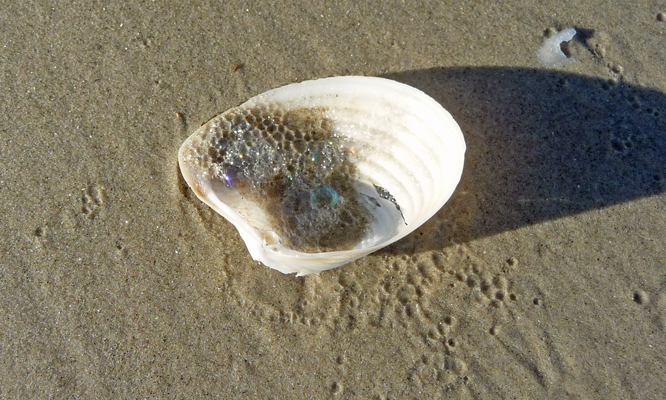
This little sanderling was running between the piles of foam and I caught him right at the right moment.
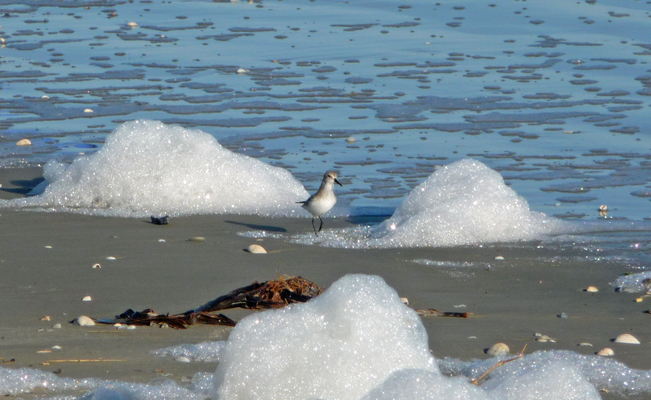
The sanderlings had wide enough range of different coloring for me to keep taking photos of them thinking that they were different kinds of birds.
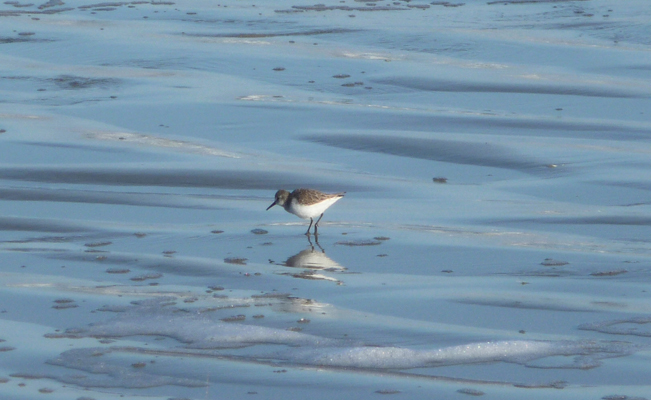
In the end, I was rewarded for this behavior when I discovered that I’d taken a photo of a Snowy Plover (another bird I’d never seen before). Snowy Plovers nest on the beach up on the Oregon Coast in the spring. You can be a ‘plover host’ in the rain and and wind in Oregon telling people about the plovers and keeping them from disturbing the nesting birds-sounds fun until you realize how cold it will be on the beach in March... I’d heard all about them over the years, but never seen one.
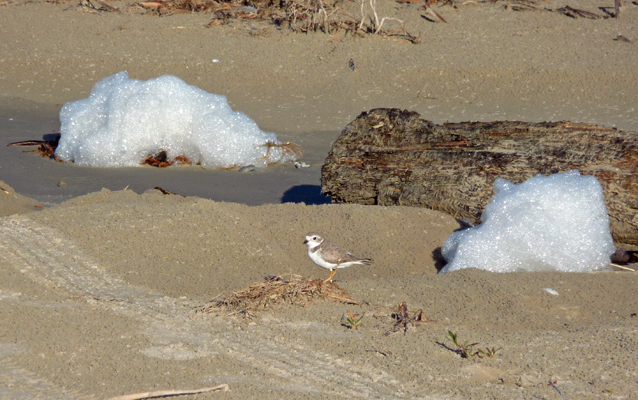
It turns out, it’s easy to confuse sanderlings and snowy plovers. The sanderlings have a longer beak and don’t have that white ‘ring’ at their neckline.
We made our way back towards the trailer and I got a shot of Genevieve and Francois from the dunes. There’s not much space between the campground and the road (where the power lines are) but the surf was noisy enough that it masked any traffic noise.
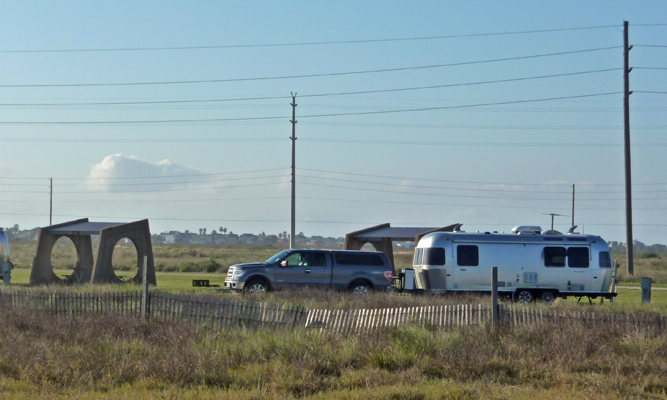
Sea turtles lay their eggs on the beaches of the barrier islands and I guess the state parks are actively involved in protecting them. However their signage makes it sound like they’re going to arrest and deport them!
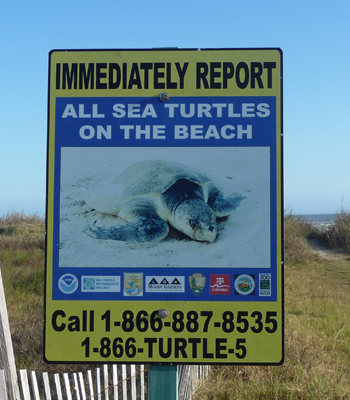
I’d love to see turtles but the closest we got to that was the new plush toys they had in the gift shop at the visitors center here.
The weather stayed nice and we even had a bit of a sunset that evening...That’s the water tower for the housing development just south of the park.
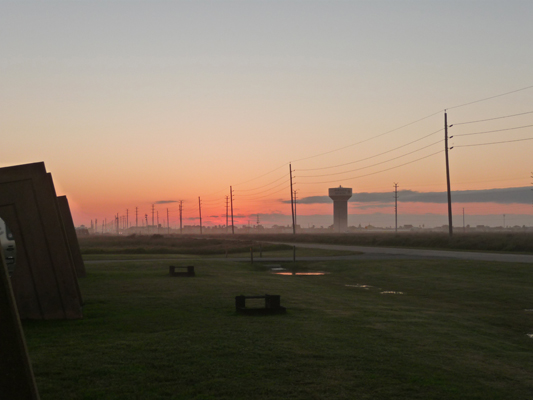
We had a bit of sun in the morning but as we packed up to go, the clouds were arriving with the next front. We drove north up the island and once again the houses got big—no these are not apartments, these are individual residences (not as fancy as one enclave just south of the park, but you get the idea).

There was fog in downtown Galveston along the seawall but once we turned inland, the fog was gone within a block. We drove north towards Houston and then skirted the city by turning west again, over the Chocolate Bayou and the Brazos River (which was running a deep chocolate color too) to Brazos Bend State Park—where you just might see an alligator or two...
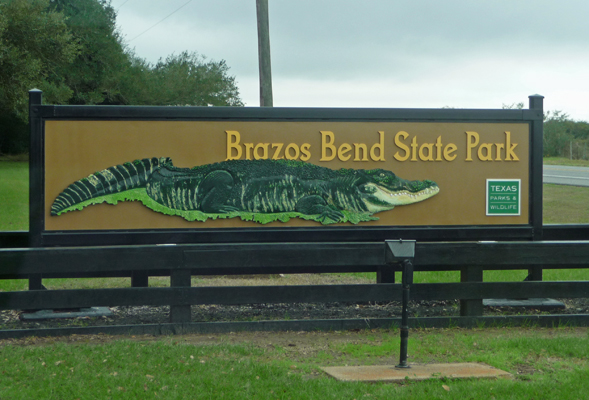
Brazos Bend is a large park containing a number of lakes and oxbows from the Brazos, plus a hardwood wetland and some coastal prairie (which is what most of this area was before it became farmland).
There are big old trees (honest to goodness tall trees for the first time) with branches lined with what look like licorice ferns (Polypodium glycyrrhiza) but are in fact Resurrection Ferns (Pleopeltis polypodioides). When it gets dry here, these guys shrivel up waiting for the next rain when they will fluff back up—clearly there’d been pleanty of rain of late.
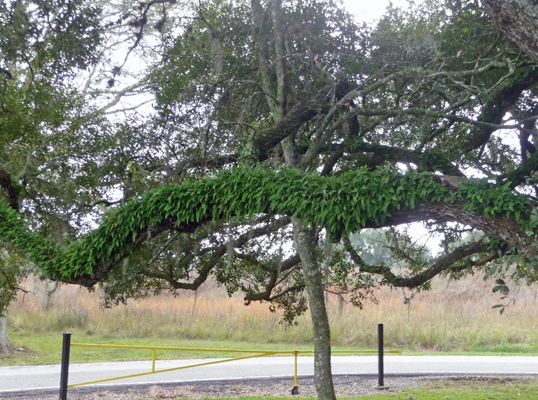
We got a nice camp site for the weekend (just $50 for 3 days with the last coupon on our State Parks Pass—saving us $52!). This is what’s called bottom land and it’s wet country. With the storms that have been rolling through this winter there was lots of standing water all through the campground. All the campsites have paved parking which means you’ve at least got that area that’s high and dry and most of the picnic tables are on concrete pads too. Palmettos growing in the lawn are an indicator of the wet conditions here. We’d seen them growing all through some pieces of property as we drove long and then across the road (and in a dryer spot) there would be none—a little bog here and little prairie there.
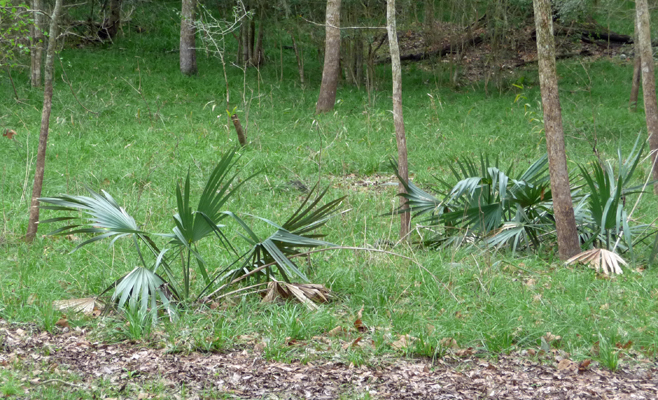
We set up camp, had lunch and decided that since it was raining and was supposed to rain for the rest of the afternoon, that we’d run an errand or two. We asked Carmine, the Garmin, for the nearest grocery store and she gave us a choice of a Kroger's or an HEB both 10 miles away. We’d passed both on our way and so we set out sure we knew where we were going... Except for one minor detail—she said they were 45 minutes away... Clearly the 10 miles was as the crow flies. She took us miles out of our way nearly to Houston! But hey, we didn’t have anything else to do and we didn’t get lost so it was okay. We did a little shopping at Kroger's (for a change of pace) and we both liked it better than the HEB even if it was WAY big too. Remember, everything is BIG in Texas.
It started to rain with some gusto as we drove back and the sky opened up with a vengeance as we hurried into the trailer. It poured off and on for several hours and there was thunder and lightening to go with it. To the northeast they had severe weather warnings (which were broadcast on the TV as a warning across the top of the screen and the buzzing of the emergency warning system) for golf ball-sized hail. Boy were we glad we just got a few ice pellets! This all at about 68 degrees and 99% humidity. The inside of the trailer was 70 degrees and 95% humidity when we went to bed and it was 61 degrees outside. Ick. But the other side of the front was on its way and we were in for a change.
We awoke on Saturday January 9th to sunshine and temps in the mid 50’s. The humidity had dropped some—thank goodness because the inside of the trailer was covered in condensation which is not an easy thing to get rid of if it’s humid outside. I wiped down the walls and ceilings and with the sunshine things got more reasonable inside and was just fine by the end of the day.
We stayed in the park for the day’s outing first making a trip to the Nature Center where among other things they have baby alligator’s you can pet.
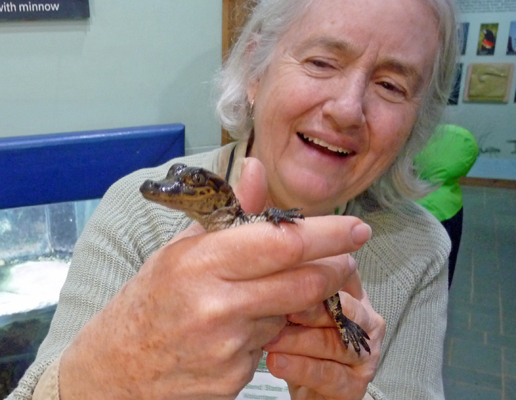
This little guy hatched back at the end of September so he’s 3 1/2 months old. He was one of 30 hatchlings from a batch of 40 eggs they had to remove from a nest that was RIGHT next to a popular trail. They incubated the eggs and got 30 babies out of the deal. They’ll keep a few here at the Nature Center for the year so folks (and lots of visiting school kids) can see and touch them and then after a year they’ll let them loose. The bulk of the hatch have already been released in the wild. There are about 300 alligators living in the marshes and lakes here in the park so they’ll be in good company.
The live oaks here are much taller than those right along the coast and come draped with Spanish Moss.
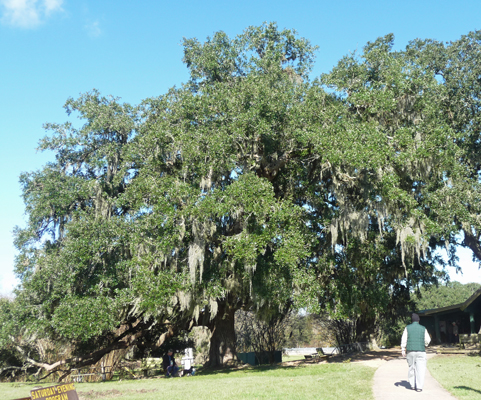
I finally decided that maybe the best way for you to experience the moss was straight up into the tree. It’s very cool stuff.
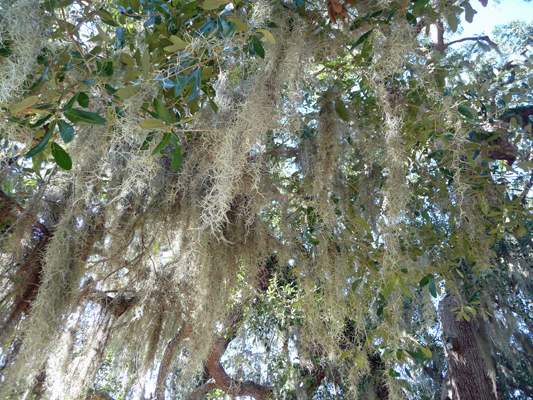
From here we drove over to the 40 Acre Lake to do the hike there. There’s a nice dock that takes you out onto the lake.
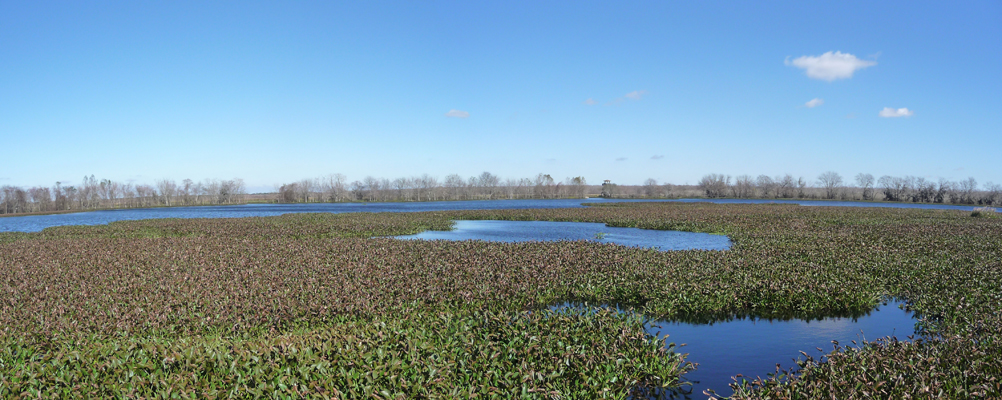
Aside from a few mud hens there were very few birds out. It was windy and I guess they were hunkered down in the reeds and grasses out in the marshes.
We took the trail that goes around the lake and here you can see that the Spanish Moss likes the elms and pecans just as much as it does the live oaks.
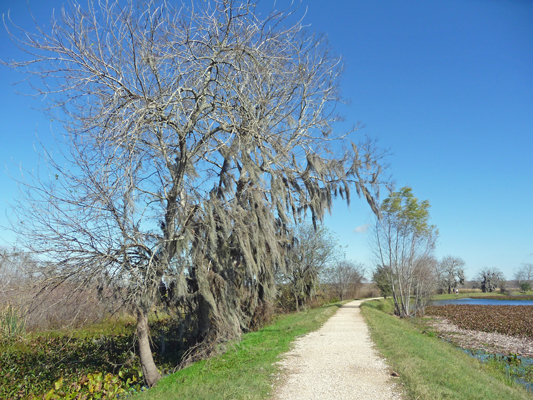
Just as we came around the bend here, Walter spied an alligator down near the edge of the water. We took a step closer and he took several—so we stepped back slowly and steadily until he settled down in the sun.
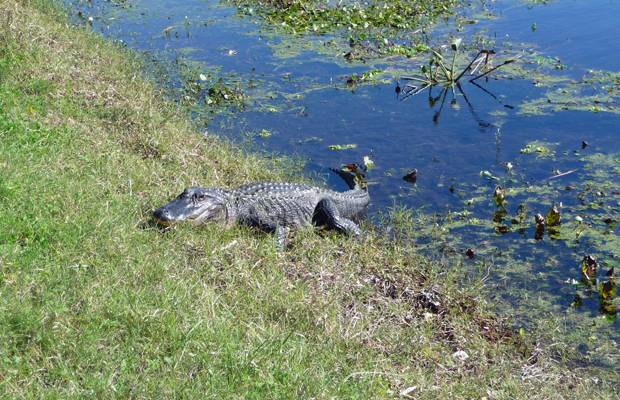
When he was quiet again we walked on by where he’d settled and I got another shot.
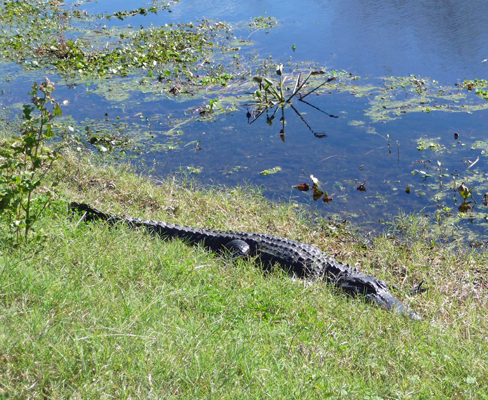
Having had our thrill for the day, we walked on to the observation tower at the other corner of the lake. This gave us a great view of the lake.

And we could see a group of 4 alligators who were sunning out on the point in the middle of the photo above. It was a long way away so it’s a little fuzzy but you can count the 4 of them and see that one of them had his mouth open.
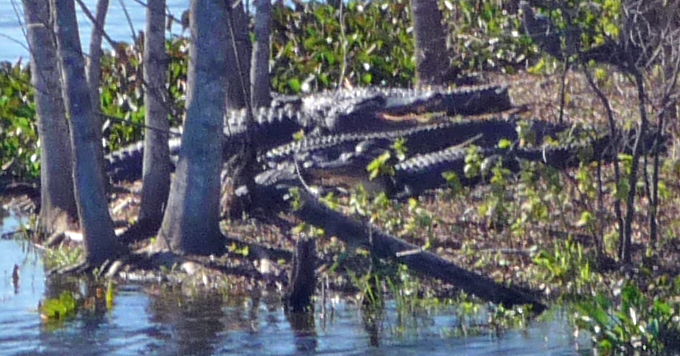
In the opposite direction from the lake you could see across the marshes. It sure is flat in this part of Texas.

Down back at lake level, I got a nice photo of a White Ibis (there were two of them but the other one didn’t stay still for me) who had been hunting for something in this shallow marsh.
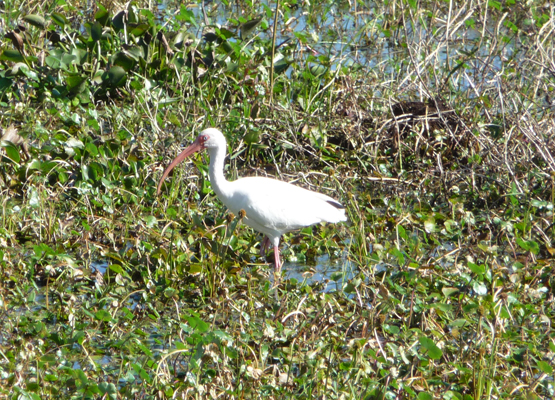
And I got a nice close up of a Little Blue Heron who almost disappeared into the background until he moved.
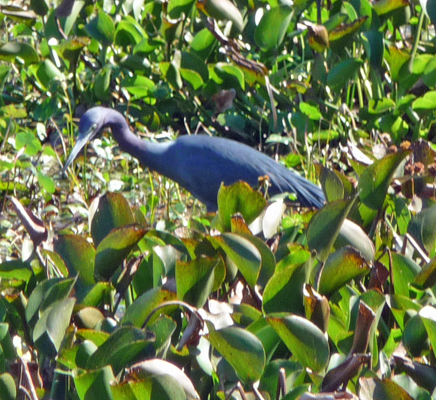
We sat on a nice bench at the edge of the lake and watched the alligators for a while and then continued on along the trail. From further along the trail a ways we got yet another decent photo op of the alligators on the point. And once again, you can see Big Daddy has his mouth open.
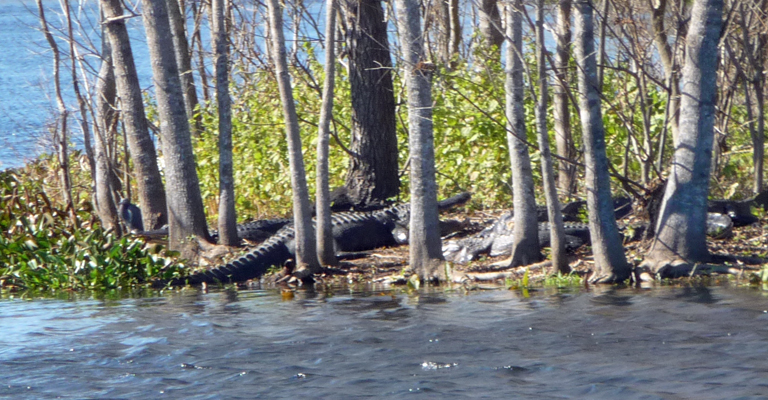
Still further along the trail a different sort of marsh opened up on our left. This time it was deeper water covered with a tiny green water plants. Did I mention that it was wet here?
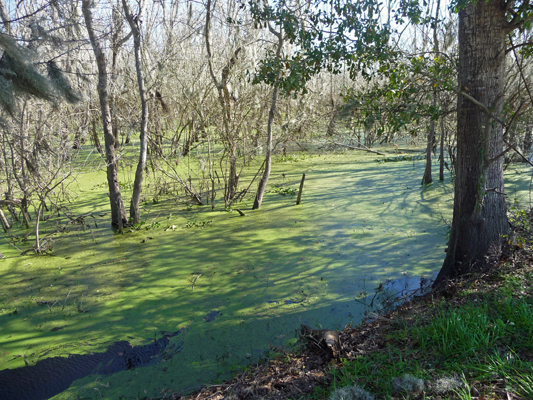
There were fresh piles of dirt here and there along the edge of the lake. Walter stopped and stepped on one and we discovered they were red ant hills. The good news is he didn’t get any ants in his shoes (or in his pants). The pasture lands around here are full of these—that means there are LOTS of ants in these parts.
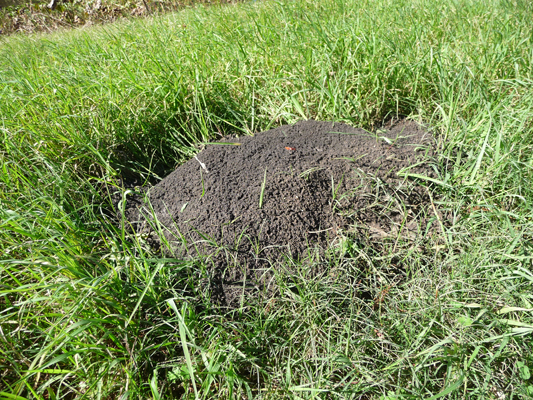
There are so many alligators in this park that not only are there alligator etiquette instructions on the trail maps but there are warning signs along the lake. Yet another reason that all dogs belong on a leash (one of our most often recited rules as camp hosts).
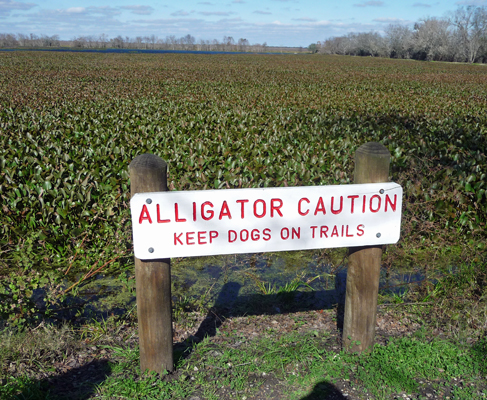
The trail takes you back through the woods on the way to the parking lot and we passed a downed tree with resurrection ferns (Pleopeltis polypodioides) growing on it so I got a nice close up of a few. They sure LOOK like they’re related to licorice ferns.
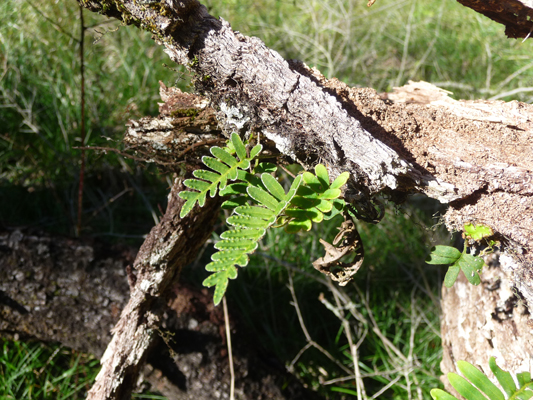
It was a nice hike—if a bit cool in the wind out by the lake—and we had a good time both out in the open and going though the tunnels of trees.
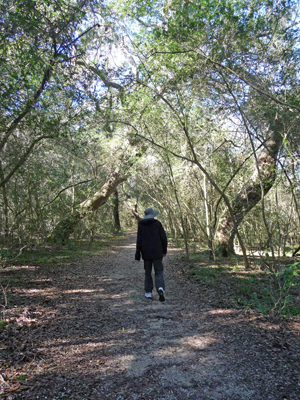
By Saturday evening the temperature was down to 45 outside—boy does the weather shift quickly here and it made it down to 37 next the morning. I’ll take cold nights over hot sticky ones though.
